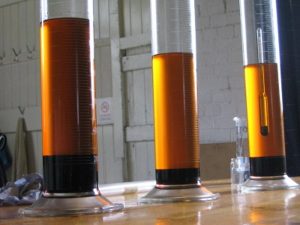The ‘basic method’ is the single-stage base-catalysed transesterification method. There are a number of variations on this method which may yield better fuel quality with certain feedstocks.
2-stage base/base method
In the chemistry section we mentioned that one way of pushing the reaction to completion was to retract the products, but that this generally required equipment such as separators. This is why we rely on excess methanol. One way to get round this is to split the reaction into two stages. The methoxide is prepared as normal and split into 2 equal parts. We perform a reaction as normal with the first half of the methoxide. We then settle out the glycerine overnight as usual .Then we react the product with the second half of the methoxide. This will pull out more glycerine. This method should result in more complete transesterification. Potentially it also allows us to reduce the amount of excess methanol. Variations on this technique exist with different proportions of methoxide used for first and second stages, and some people even do three-stage reactions like this
2-stage acid/base method
This method is useful for dealing with feedstock which is high in FFAs. The first stage involves treating the WVO to esterify the FFAs. To do this we need methanol and an acid catalyst such as concentrated sulphuric acid (nitric acid must not be used in biodiesel chemistry as it may create nitro-glycerine!). The FFAs are esterified and turn to methyl esters (biodiesel). The second stage is the normal base-catalysed reaction but the titration should show that the oil is now very low in FFAs. Less lye will be needed.
This reaction is much better for high FFA feedstocks. Instead of turning the FFAs to soaps which can cause problems with the washing stage, we turn them into biodiesel! The downside is that it involves handling concentrated acid and that it complicates the procedure somewhat. It has been touted as an easy or ‘foolproof’ method but it is really a more advanced technique. You need to master the standard method before trying this one.
There are also variations on this method. Some people reverse it, using base to turn all the WVO to FFAs and then esterifying the whole lot with an acid catalyst. This is useful for feedstocks like tallow or trap grease.
Storage
Biodiesel is much safer to store than mineral diesel. It is non-toxic, biodegradable, and has a higher flashpoint. Like petrodiesel, algae can grow in biodiesel causing slime to gunk up fuel lines and filters. Storage containers should be clean, dry and dark to avoid algae formation. Also like petrodiesel, biodiesel is hygroscopic: it will absorb water over time. Avoid copper, zinc or tin for long-term storage of biodiesel: mild steel, aluminium, stainless steel or polyethylene are good.

